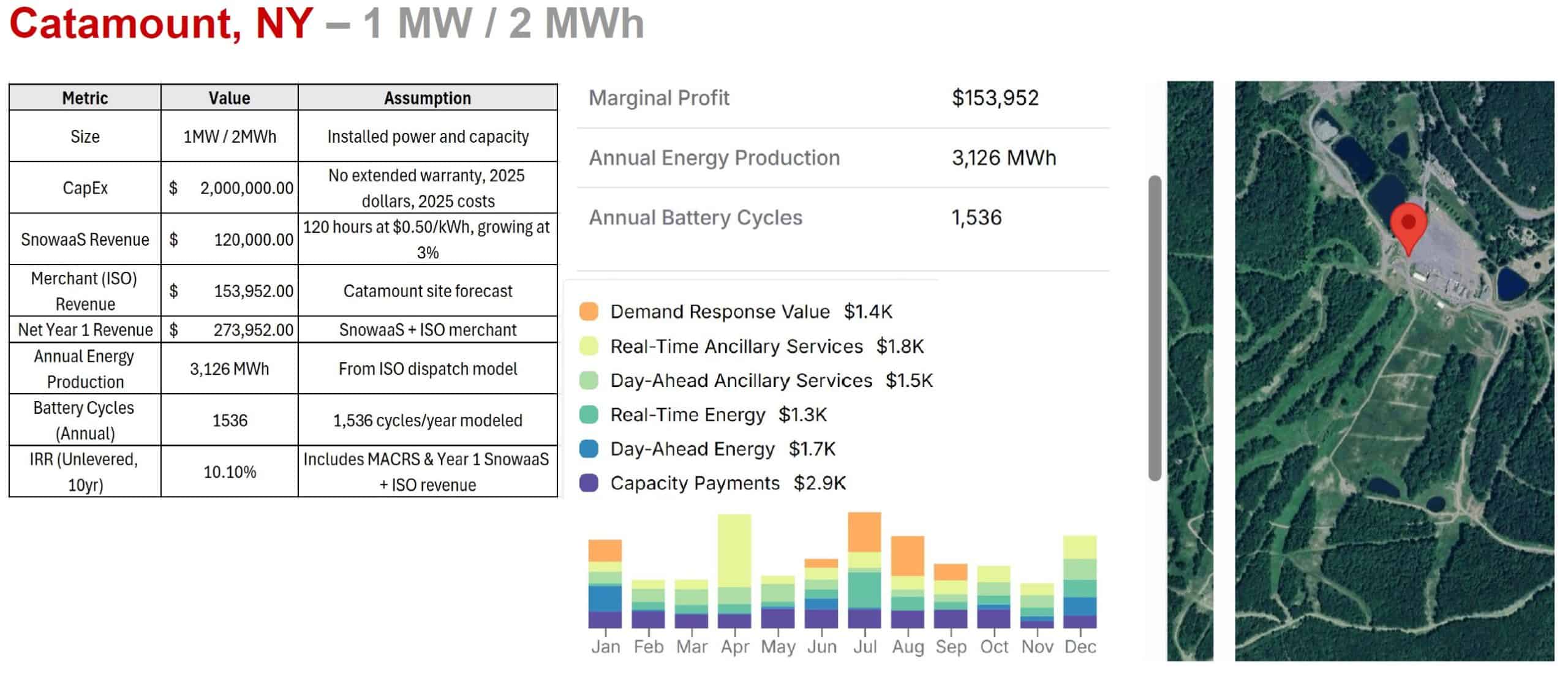In July 2025, CutPeak Energy submitted a proposal to NYSERDA under PON 5848, Category C, to evaluate the technical and economic feasibility of merchant-supported battery energy storage systems (BESS) for rural, winter-peaking ski areas. The study focuses on simulating how BESS can be used to reduce peak electricity costs and participate in grid markets—while supporting snowmaking operations, and no capital expense to the ski area.
Core Objectives
We’re modeling how a battery could support snowmaking while reducing energy costs.
Ski areas face three main problems:
- High energy bills from snowmaking, especially peak demand charges
- Limited electrical capacity—you can’t always run everything at once
- Reliance on diesel for backup or to avoid peak usage, which is expensive and dirty
This study tests whether battery-paired snowmaking can:
- Extend ski days to mitigate weather-dependent risk
- Cut demand charges by discharging during snowmaking peak demand
- Free up capacity so you can run more guns when the weather window opens
- Reduce the need to fire up a genset
- Generate enough grid revenue to fund itself, so you don’t have to
We’re not guessing. We’re using real snowmaking data from Catamount and working with dispatch and utility partners to model actual performance. The goal is to prove whether this works financially and operationally—not just on paper, but in the real world conditions, those ski areas operate in.
Why Catamount Mountain Resort?
Catamount represents a typical Northeast ski area:
- Climate-risk and warming winters threatening ski days
- Aggressive snowmaking demands with compressed scheduling
- Rural utility interconnect on a capacity-constrained feeder
Catamount is uniquely suitable because the NY/MA state line runs through the parking lot and the ski area is served by both National Grid and NYSEG. This allows us to test the impact of different utility programs and state policies.
Technical Scope
✅ Get the Data Right
- Collect load data, snowmaking schedules, utility bills
- Map electrical layout and feeder constraints
✅ Simulate the Battery
- Install a site controller to mimic BESS behavior (non-exporting)
- Log how it would respond to peak loads and market signals during real operations
✅ Run the Numbers
- Model NYISO market participation and utility savings
- Simulate both backward (past years) and forward-looking scenarios
✅ Measure the Impact
- Estimate CO₂e reductions from less diesel
- Interview local businesses to understand potential economic benefits of longer seasons
✅ Build Tools & Reports
- Package everything for other ski areas, utilities, and policy groups
- Answer key questions: what size battery, how is it paid for, what if snow hours change by more than 20%?
✅ Final Report
Deliver a full, public-facing report showing what worked, what didn’t, and how it could be replicated.
Why This Matters
Most ski areas can’t avoid demand charges—not because they don’t want to, but because they have to blow snow whenever conditions allow. The windows are tight, the pressure to open is high, and system capacity is often already stretched. That means pumps, fans, and compressors come online all at once, triggering peak demand charges. Batteries don’t fix this by reducing snowmaking—they help by absorbing some of that peak load at the right moment, flattening the profile without changing how snow is made.
This proposal aims to test exactly that: Can BESS deliver both site-level savings and grid value—without requiring capital from the operator?
Status & What’s Next
This proposal is currently under NYSERDA review and has not yet been awarded.
However, strong support letters from all our strategic partners including both NYSEG, National Grid, which shows a shared belief in the impact of the study. We’re grateful to every partner who contributed letters of commitment, especially given tight timelines.
Whether awarded or not, the mission will continue—and we remain committed to helping ski areas across the Northeast become smarter energy users and valuable grid assets.
And yes, we’re doing our snow dance!
—
CutPeak Energy


Leave a Reply